Did you know that Florida is one of the top four producers of watermelon in the United States? In fact, this crop generated over $123 million in Florida in 2016 alone. Here in the southeast, growing season typically begins in April, peaking in May and June, with a second season kicking off in September and October. Of course, with rising temperatures and humidity comes a litany of potential diseases which may cause detriment to this cucurbit crop. As a vining, annual plant, watermelon is susceptible to a variety of pathogens which may attack several parts of the plant including fruit, foliage, and even roots.
Phytophthora blight and fruit rot (Phytophthora capsici): All stages and parts of the plant can become infected by this fungal pathogen. However, symptoms are most commonly observed on the fruit and include irregular, brown lesions which will rapidly expand to an oval shape with concentric rings. Signs of the fungal pathogen may be observed as white, fuzzy mycelium on both the stem and rind of the fruit, appearing as greasy blotches. This pathogen is most commonly observed after periods of heavy rainfall and excessive moisture.
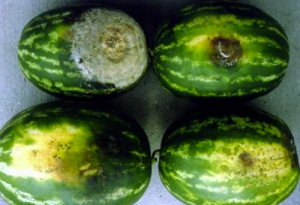
Fusarium wilt (Fusarium oxysporum): As the name implies, symptoms of this pathogen include severe wilting, which is more common on younger plants and will begin on one side, eventually spreading to the entire plant. The vascular tissue of the crown area may turn reddish-brown in color and as the disease progresses the roots may also turn dark brown.
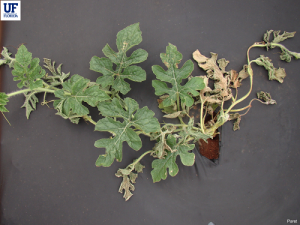
Anthracnose (Colletotrichum orbiculare): This seed-borne fungal pathogen may infect leaves, fruit, and stem tissue. Early symptoms on leaves include brown, angular lesions with a yellow border. Stem lesions are generally deeper and more elongated, while lesions present on fruit will be slightly raised with a sunken center.
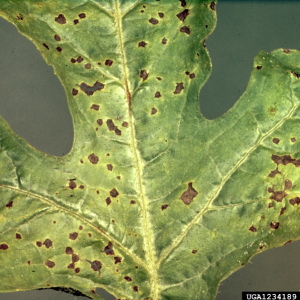
Downy mildew (Pseudoperonospora cubensis): This is a fungal-like pathogen (an oomycete), which primarily infects leaf tissue. Appearing initially as yellow, mottled spots with no definitive border, these lesions will turn dark-brown in color as they mature, with leaves curling upward.
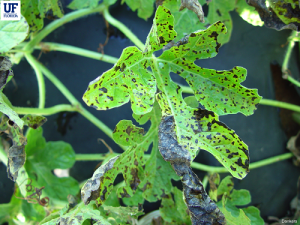
Gummy stem blight (Didymella bryoniae): This fungal disease may look very similar to anthracnose, with symptoms such as damping off, rotting of the crown area and fruit, leaf spots, canker on the stem. Lesions present on the stem and fruit may ooze an amber color liquid, giving it it’s name “gummy” stem blight.
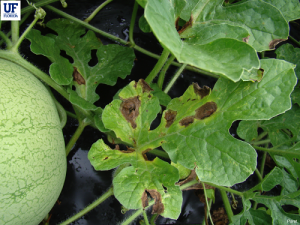
As many of these pathogens are spread by wind and water, it’s always a good idea to keep an eye on weather patterns in your area and spread your planting dates out accordingly. Always remember to diversify your cultivars, planting disease-resistance types when possible. Rotating your watermelon with grass or legume crops is also highly recommended. Fungicides should be utilized as a part of your seasonal program, taking care to consult with FRAC or your local county extension office for more information.
Be sure to check out these additional resources for more detailed lists of potential pathogens of watermelon and suggestions for management: Florida Plant Disease Management Guide: Watermelon, Vegetable Production Handbook of Florida: Chapter 7. Cucurbit Production.
 2
2
